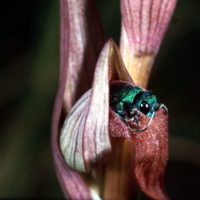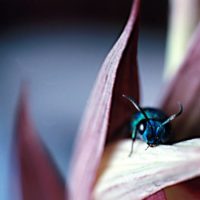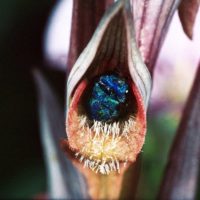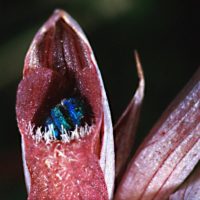Last updated on June 7th, 2020
Relations between Chrysura refulgens Sp. (Hymenoptera Chrysididae) and Serapias vomeracea laxiflora (Orchidaceae)
Text and photos by L. Filippi
May 1997, Tuscany, Italy. Chrysura refulgens Sp. is observed inside a Serapias vomeracea laxiflora (Orchidaceae) flower. The specimen, a male, has 4 pollinic masses attached to the abdomen.
The Genus Serapias L. has about 20 species and subspecies of spontaneous orchids, about 7-8 of them diffused in Italy. Serapias vomeracea laxiflora is a plant 15-55 cm tall, with inflorescences of 3-10 flowers; each flower has petals and sepals united to form a sort of helmet, very showy.
Following the shifting of the chrysidid, in the afternoon the specimen occupied a flower different from the morning, but of the same plant. At 09:30 a.m. of the day after the chrysidid occupied the same flower of the morning before, and left it at 10:30 a.m. At 15:30 a new flower was occupied. Observations taken in the subsequent days revealed that the chrysidid was occupying flowers belonging to two distinct but close plants, moving with a good regularity and targeting the flowers best exposed to the sun.
The Chrysura refulgens male was resting inside the flower with the head towards the outside (fig. 1 & 2), but also in an opposite way, with the abdomen upwards and the head downwards. The second position was preferred also by Megachile centuncularis (Aculeata Apoidea Megachilidae). This way, the flower was attaching its pollinic masses to the insect’s body and a transport to other flowers was assured (pollination).
![]() click images to enlarge:
click images to enlarge:
The shifting of the chrysidid from flower to flower were interpreted through the temperatures sampled with a microtermometer both inside and outside the flowers. The chrysidid, during the day, rests in a flower directly exposed to the sun and in the late afternoon occupies the flower that will be warmed as first. Flowers directly exposed to the sun have internal temperatures higher than flowers in the shadow, and higher than the outside (positive delta of 3.1 – 3.3 °C).
The temperature of the already pollinated flowers is less higher than the not yet pollinated ones, so that the former ones are less targeted by the chrysidid. Withered flowers do not reveal any difference in temperature from the external environment.
References
- Felicioli A., Strumia F., Filippi L. & Pinzauti M., 1998 – Observations on the relations between Orchids of the genus Serapias and their pollinators in an area of central Tuscany. Frustula ent., 21: 103-108.
- Filippi L., 2001 – Alcuni giorni in compagnia di Serapias vomeracea laxiflora (Orchidaceae) e di Chrysura refulgens (Hymenoptera Chrysididae). HY-MEN, 10: 11-13.
Copyright, Authorship, and Ownership statements
All text and images of this page are copyright ©️ Chrysis.net unless otherwise stated - please see individual cases for authorship and copyright details. The specimens pictured are from the authors' or other collaborators' personal collections and from the collections of various museums. Unless otherwise specified, the whole content of this web site is for personal, non-commercial, scientific, and educational purposes given proper accreditation to the page from which they were derived are provided, and under Chrysis.net Terms and Conditions.
For citation purposes
Agnoli G.L. & Rosa P. (2025) Chrysura refulgens and Serapias vomeracea laxiflora, in: Chrysis.net website. Interim version 18 July 2025, URL: https://www.chrysis.net/chrysididae/chrysura-refulgens/.








